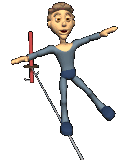
The baby is in trouble from the start, but with derring-do, drastic action and a mixture of mouse meat, curator and keeper help the bird through a rocky start
Saturday, May 24, 2008KATY MULDOON The Oregonian Staff:
Shawn St. Michael held the California condor egg up to a bright light. Inside, he saw the chick push its scrawny neck against the membrane inside the shell, struggling to hatch.
The egg had looked like trouble from the start, its embryo malpositioned on the yolk. St. Michael, the Oregon Zoo's condor curator, had worried the little bird wouldn't be situated properly to hatch when its time came in early May.
He was right.
By May 5 or 6, he knew he'd have to intervene, but if he did too soon, he remembers thinking, he risked nicking a vessel and the chick could bleed to death. Wait too long, and it would suffocate.
St. Michael had helped birds hatch before: parrots, penguins and three other condors. But this was more special than most. Only about 300 California condors exist, and this chick, if it survived, was the offspring of a male that hadn't reproduced before -- a genetic gem.
St. Michael worked quickly in a garage-turned-veterinary hospital at the zoo's Jonsson Center for Wildlife Conservation in Clackamas County.
Using a sterile needle, he bored a tiny hole through the fist-sized, green-tinged shell to give the chick oxygen. With a hemostat, he carefully snipped away shell fragments until the hole was the size of a pencil eraser.
He remembers lifting the egg off the heating pad where he worked and holding it to his ear. St. Michael heard faint inhalations and exhalations -- whispers of life.
Without human intervention, condor chicks usually hatch about 72 hours after first cracking their shells.
St. Michael placed the egg back in its incubator and waited.
When the time came, with keeper Kelli Walker assisting, St. Michael retrieved the egg. Working at a stainless steel table under a bright light, the heat cranked to about 80 degrees, she held the egg steady while he cut more shell from its wider end. Once the hole was big enough, St. Michael gently lifted the chick's fleshy, bald head and frail body from the egg. Its creamy white feathers, wet and stringy, looked pasted to its torso.
The chick weighed 153 grams, or slightly more than 5 ounces. It was the smallest condor chick the zoo had seen since it joined the effort to breed the endangered species in 2001. Most hatchlings weigh about 183 grams, or about an ounce more.
St. Michael wrapped the new arrival loosely in sterile paper and placed it in a Plexiglas isolette, its thermostat set to about 90 degrees.
Hatching is exhausting, even for the healthiest condor chicks. But typically after a rest, the birds perk up, move around and start looking for food.
This one looked weak and acted lethargic.
St. Michael consulted Mitch Finnegan, the zoo's veterinarian, then hooked the chick to a saline IV drip to ensure it was hydrated. He fed his little charge a mixture of mouse meat and the human nutrition supplement Pedialyte. He X-rayed it to check for internal trouble, then added an antibiotic to the chick's IV.
Still, the chick was too weak to hold up its head.
Without drastic action, St. Michael remembers thinking, the prized chick would die. He'd never given a condor a transfusion, but it was time to try.
The zoo's condor operation sits in a remote meadow surrounded by woods -- a spot that, by design, feels far from civilization. The more that keepers can simulate a wild environment, the better prepared the birds bred there will be able to survive in the wild. Keepers tiptoe around and keep an eye on the condors largely through remote cameras.
Catching an adult condor blood donor, St. Michael figured, wouldn't be easy. If he raised a ruckus, he risked upsetting the three condor pairs already raising chicks. They could end up as casualties.
St. Michael, Walker and Finnegan quietly went to work. Walker baited a holding area with food, then retreated. Through a camera, the three watched a young adult female named Nootka enter the pen and start to eat. They slid the door shut so the bird couldn't escape, then rushed in.
St. Michael slapped a net over the enormous condor, whose wings span more than 9 feet. Walker grabbed the bird's head and held her powerful beak shut. St. Michael clutched her legs and wings to keep them still. Finnegan stabbed a needle into a vein in Nootka's leg and drew a vial of blood.
They slid open the door into the bird's pen. She scampered off.
Nearby in the condor hospital, Finnegan found a tiny vein in the hatchling's neck, inserted a needle and pushed the adult bird's blood into the newborn.
St. Michael slipped a sliver of a tube down the chick's throat and drained gas bloating its gut.
By the next afternoon, the chick, whose gender is still unknown, was alert, moving and hungry.
Keepers fed it, as they will until it fledges at about 4 months old, with a puppet built to look like a condor parent. After that, the real deal -- a mentor condor -- will take over. The mentor will teach the chick, which weighed almost 19 ounces this week, the ways of a world where not only newcomers, but their entire species, struggle to survive.
Katy Muldoon: 503-221-8526; katymuldoon@news.oregonian.com
Sunday, May 25, 2008
Condor chick at Oregon Zoo gets a crack at life
Labels: .circus., chick, condor, endangered, oregon zoo
Subscribe to:
Post Comments (Atom)















0 comments:
Post a Comment